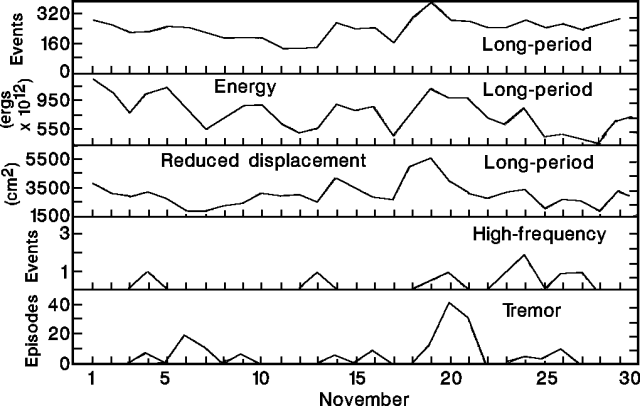Report on Galeras (Colombia) — November 1991
Bulletin of the Global Volcanism Network, vol. 16, no. 11 (November 1991)
Managing Editor: Lindsay McClelland.
Galeras (Colombia) Continued deformation and seismicity; dome petrology
Please cite this report as:
Global Volcanism Program, 1991. Report on Galeras (Colombia) (McClelland, L., ed.). Bulletin of the Global Volcanism Network, 16:11. Smithsonian Institution. https://doi.org/10.5479/si.GVP.BGVN199111-351080
Galeras
Colombia
1.22°N, 77.37°W; summit elev. 4276 m
All times are local (unless otherwise noted)
Seismicity remained at very high levels in November, with peaks in the number and intensity of long-period events on the 19th (figure 49). The average earthquake rate dropped briefly in early November, before returning to late-October levels. High-frequency seismicity, rare during November, showed a small increase centered beneath the volcano's W sector, near the end of the month. One shock was felt nearby (at the Galeras Military Base) on 18 November at 0627, and was associated with a tremor episode. Low-frequency (1-2 Hz) tremor bands, with 6 mm amplitudes, were recorded on 10 and 19 November; spasmodic tremor fluctuated, reaching a peak on 20 November.
The electronic tiltmeters located 0.9 km E ("Crater") and 2 km E ("Peladitos") of the crater showed continued inflation through 18 November, when a sudden change occurred (see figure 58), coinciding with a minimum in the reduced displacement of the long-period events. Inflation resumed at Crater Station, but measurements at Peladitos Station showed little change.
The dome in the summit crater was still growing in mid-November, as frequent explosions continued. Preliminary analyses of a block believed to have been ejected from the dome by an explosion show it to be a 2-pyroxene andesite. The rock is highly crystalline (>50% crystals), containing abundant plagioclase, and lesser clinopyroxene, orthopyroxene, titanomagnetite, and possible relict olivine. The glass is generally brown, and somewhat vesicular. Geologists noted that the rhyolitic glass composition and high crystallinity indicate a high degree of differentiation and high magma viscosity, consistent with the dome being part of an older gas-poor magma body forced upward by new magma that has not yet reached the surface.
Geological Summary. Galeras, a stratovolcano with a large breached caldera located immediately west of the city of Pasto, is one of Colombia's most frequently active volcanoes. The dominantly andesitic complex has been active for more than 1 million years, and two major caldera collapse eruptions took place during the late Pleistocene. Long-term extensive hydrothermal alteration has contributed to large-scale edifice collapse on at least three occasions, producing debris avalanches that swept to the west and left a large open caldera inside which the modern cone has been constructed. Major explosive eruptions since the mid-Holocene have produced widespread tephra deposits and pyroclastic flows that swept all but the southern flanks. A central cone slightly lower than the caldera rim has been the site of numerous small-to-moderate eruptions since the time of the Spanish conquistadors.
Information Contacts: INGEOMINAS-OVP; J. Stix, Univ de Montréal.


